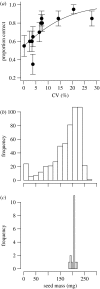Seed size variability: from carob to carats
- PMID: 17148413
- PMCID: PMC1686184
- DOI: 10.1098/rsbl.2006.0476
Seed size variability: from carob to carats
Abstract
The seeds of various plants were used as weights because their mass reputedly varies so little. Carob (Ceratonia siliqua), which has given its name to the carat, is particularly famous in this regard. But are carob seeds unusually constant in weight and, if not, how did the myth arise? The variability of seeds sampled from a collection of carob trees (CV=23%) was close to the average of 63 species reviewed from the literature (CV=25%). However, in a perception experiment observers could discriminate differences in carob seed weight of around 5% by eye demonstrating the potential for humans to greatly reduce natural variation. Interestingly, the variability of pre-metrication carat weight standards is also around 5% suggesting that human rather than natural selection gave rise to the carob myth.
Figures



References
-
- Banuelos M.J, Obeso J.R. Maternal provisioning, sibling rivalry and seed mass variability in the dioecious shrub Rhamnus alpinus. Evol. Ecol. 2003;17:19–31. doi:10.1023/A:1022430302689 - DOI
-
- Batlle I, Tous J. Institute of Plant Genetics and Crop Plant Research & International Plant Genetic Resources Institute; Gatersleben, Germany & Rome, Italy: 1997. Carob tree. Ceratonia siliqua L. Promoting the conservation and use of underutilized and neglected crops. 17.
-
- Bauer M. Dover Publications Inc.; New York, NY: 1969. Precious stones.
-
- Bernasconi G. Seed paternity in flowering plants: an evolutionary perspective. Perspect. Plant Ecol. Evol. Syst. 2004;6:149–158. doi:10.1078/1433-8319-00075 - DOI
-
- Daniel P. The carat—its origin as a unit of weight for diamond. Phys. Educ. 1972;7:454–455. doi:10.1088/0031-9120/7/7/317 - DOI
MeSH terms
LinkOut - more resources
Full Text Sources

